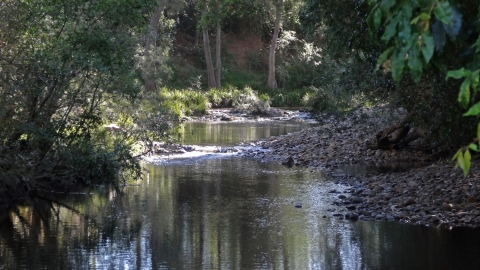- Home
- Assessments
- Bioregional Assessment Program
- Methods
- Surface water modelling
- Appendix B Proposed structure of product 2.6.1 (surface water numerical modelling) and product 2.5 ...
- Appendix B Proposed structure of product 2.6.1 (surface water numerical modelling) and product 2.5 (water balance assessment)
Table B.1 Recommended content for product 2.6.1 (surface water numerical modelling)
|
Section number |
Title of section |
Main content to include in section |
|---|---|---|
|
2.6.1.1 |
Methods |
This will be mostly generic text. Overarching information about how the groundwater and surface water models are linked is included here. |
|
2.6.1.2 |
Review of existing models |
Discussion of any models that have been used for regional coal resource development modelling. |
|
2.6.1.3 |
Model development |
If there is more than one model, include level 5 headings as follows. Not required if just one model. 2.6.1.3.1 Model #1 2.6.1.3.2 Model #2 |
|
2.6.1.4 |
Calibration |
If there is more than one model, include level 5 headings as follows. Not required if just one model. 2.6.1.4.1 Model #1 2.6.1.4.2 Model #2 |
|
2.6.1.5 |
Uncertainty |
|
|
2.6.1.6 |
Prediction |
Table B.2 Recommended content for product 2.5 (water balance assessment)
|
Section number |
Title of section |
Main content to include in section |
|---|---|---|
|
2.5.1 |
Methods |
|
|
2.5.1.1 |
Spatial and temporal extent of the water balances |
Temporal resolution: The water balance is reported over three 30-year periods, namely 2013 to 2042, 2043 to 2072 and 2073 to 2102, which align with the three global warming scenarios of 1.0, 1.5 and 2.0 °C. Spatial resolution: This will vary by subregion, but a general principle is to report the water balance over the minimum possible area which incorporates all hydrologically connected cumulative impacts. Thus more than one might be required per subregion or bioregion. |
|
2.5.2 |
Water balances |
Suggestions for level 4 headings are either: inflows, consumptive use and discharge, or a subheading for each water management unit. |
|
2.5.2.1 |
Reporting unit #1 |
Number of tables: Three tables will be needed for each spatial reporting unit – one for each of the three time slices. Each will contain results under the baseline, under the CRDP, and the difference. Uncertainty: Within each table, for some outputs, three numbers will be required representing the median, 10th and 90th percentiles from the uncertainty analysis. For some outputs (e.g. rainfall) this will not be required. Table 1 Water balance in [insert reporting unit name] for 2013 to 2042 Table 2 Water balance in [insert reporting unit name] for 2043 to 2072 Table 3 Water balance in [insert reporting unit name] for 2073 to 2102 |
|
2.5.2.2 |
Reporting unit #2 |
Number of tables: Three tables will be needed for each spatial reporting unit – one for each of the three time slices. Each will contain results under the baseline, under the CRDP, and the difference. Uncertainty: Within each table, for some outputs, three numbers will be required representing the median, 10th and 90th percentiles from the uncertainty analysis. For some outputs (e.g. rainfall) this will not be required. Table 1 Water balance in [insert reporting unit name] for 2013 to 2042 Table 2 Water balance in [insert reporting unit name] for 2043 to 2072 Table 3 Water balance in [insert reporting unit name] for 2073 to 2102 |
|
2.5.2.3 |
Gaps |

METHODOLOGY FINALISATION DATE
- 1 Background and context
- 2 Components of surface water modelling
- 3 Streamflow modelling
- 4 River system modelling
- 5 Constituent modelling
- 6 Modelling the impacts of coal resource development
- 7 Linkages with other modelling components
- 8 Outputs from surface water modelling
- Appendix A Modifications to AWRA-R
- Appendix B Proposed structure of product 2.6.1 (surface water numerical modelling) and product 2.5 (water balance assessment)
- References
- Datasets
- Citation
- Acknowledgements
- Contributors to the Technical Programme
- About this submethodology
